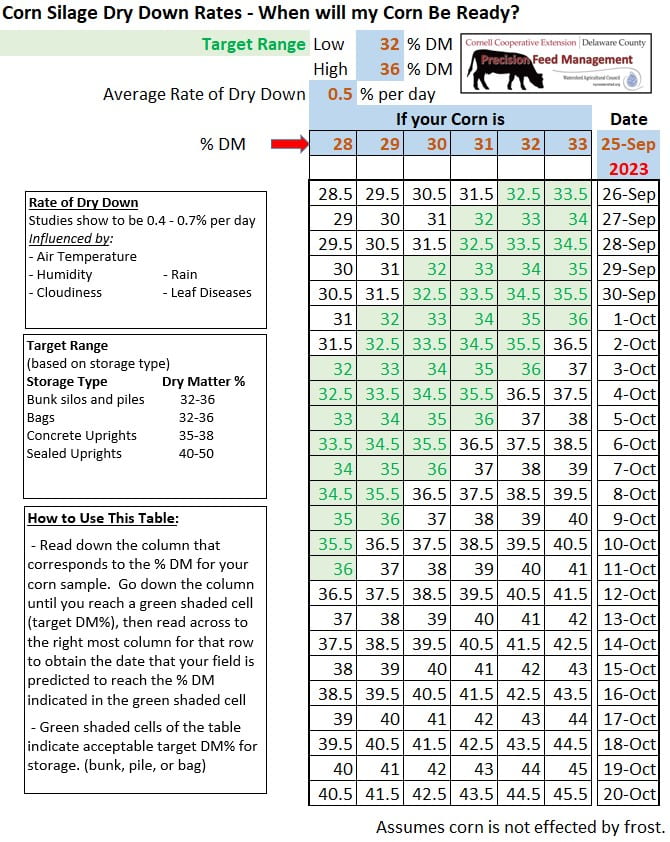
Corn generally looks good in the region, but the dry spring and wet summer have resulted in lots of variability in many fields. Corn maturity is behind average, and most samples tested were a week or more away from recommended silage moisture. The only way to be sure of picking the best harvest timing is to base your decision on whole plant dry matter.
CCE and WAC teamed up with Dairy One, and their portable NIR, to test corn dry matter this week and the results are in the chart below. Samples varied from ¾ milk line to ears still in milk stage, but ear stage alone was not adequate to guess dry matter (DM) content. DM is the best way to decide on harvest readiness, because it best predicts fermentation quality. We recommend 32 – 36% DM for bunk silos and bags, 35 – 38% DM for upright silos. Remember proper length of cut, thorough kernel processing, and adequate packing are all critical in making quality corn silage.
The samples tested on September 25th averaged 26% DM with a range of 22% DM to 31% DM. All samples were rain soaked and we estimate that that likely added a point or two of moisture to each sample. You may want to add one or two points to the measured DM to estimate harvest DM for each field. With the help of the Dairy One NIR, were able to measure starch content as well, which averaged 30% with a range between 25% and 34%.
As corn matures it will increase in starch content, and increase in yield. Harvesting too early will sacrifice yield and energy content. Harvesting too late will yield poorer fermentation and lower starch digestibility. Corn will mature and dry down at about ½ to ¾ point of DM per day. See next page for more details.
Continuing to monitor whole plant DM is critical. Getting DM into the target zone yields best fermentation. Use of reputable inoculants helps on corn silage, especially when it is getting dry. Inoculants containing Lactobacillus Buchneri have been shown to be effective with corn silage. Increasing chop length with wetter silage may also reduce silo juicing.
With the delayed maturity of many fields, the risk of frost before fields reach target DM is high. If fields are frosted before harvest, watch DM closely, since frosted fields will often lose moisture quickly.
| Town | Ear Maturity | DM% | Starch % |
| Andes | E. Dent | 25 | 29 |
| Andes | ⅔ milk line | 26 | 31 |
| Andes | E. Dent | 28 | 31 |
| Andes | ⅓ milk line | 30 | 33 |
| Ashland | ½ milk line | 24 | 30 |
| Davenport | ¾ milk line | 31 | 32 |
| Delhi | ½ milk line | 27 | 30 |
| Harpersfield | ½ milk line | 31 | 34 |
| Jefferson | Milk | 26 | 29 |
| Kortright | Milk | 22 | 25 |
| Kortright | E. Dent | 22 | 26 |
| Kortright | Milk | 24 | 27 |
| Kortright | E. Dent | 24 | 28 |
| Kortright | E. Dent | 25 | 29 |
| Kortright | ¼ milk line | 25 | 30 |
| Kortright | ⅓ milk line | 25 | 29 |
| Kortright | ¼ milk line | 25 | 29 |
| Kortright | E. Dent | 26 | 29 |
| Kortright | Milk | 26 | 30 |
| Kortright | ¼ milk line | 26 | 30 |
| Kortright | E. Dent | 26 | 30 |
| Kortright | E. Dent | 27 | 31 |
| Kortright | ¼ milk line | 27 | 30 |
| Kortright | ⅓ milk line | 28 | 32 |
| Kortright | ⅓ milk line | 28 | 29 |
| Kortright | E. Dent | 28 | 30 |
| Kortright | ¾ milk line | 30 | 33 |
| Meredith | E. Dent | 25 | 29 |
| Prattsville | ½ milk line | 28 | 32 |
| Roscoe | Milk | 24 | 28 |
| Roscoe | Milk | 25 | 27 |
| Roscoe | Milk | 26 | 30 |
| Roxbury | E. Dent | 24 | 30 |
| Roxbury | E. Dent | 25 | 29 |
| Roxbury | ½ milk line | 27 | 31 |
| Sharon | ½ milk line | 29 | 34 |
| Stamford | ¼ milk line | 23 | 29 |
| Stamford | E. Dent | 25 | 30 |
| Summit | ¼ milk line | 28 | 33 |
| Summit | E. Dent | 28 | 33 |
| Tompkins | ⅔ milk line | 31 | 34 |
| Walton | Milk | 26 | 29 |
| Average | 26 | 30 |


Thanks to Dairy One Integrated Farming Solutions for coming to both dry down days and providing rapid analysis of our samples!

